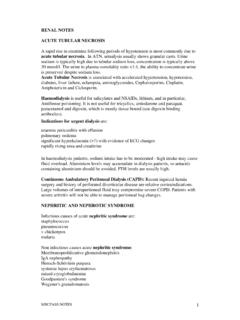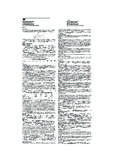Transcription of INFECTION WITH EPIZOOTIC HAEMATOPOIETIC …
1 2019 OIE - Manual of Diagnostic Tests for Aquatic Animals - 14/11/20191 CHAPTER WITH EPIZOOTIC HAEMATOPOIETIC necrosis VIRUS1. ScopeInfection with EPIZOOTIC HAEMATOPOIETIC necrosis virus means INFECTION with the pathogenic agent epizootichaematopoietic necrosis virus (EHNV) of the Genus Ranavirus of the Family Disease Agent Aetiological agent, agent strainsEHNV is a member of the genus Ranavirus in the family Iridoviridae with the type species Frog virus 3 (FV3)(Chinchar et al., 2005). Other species include Bohle virus (BIV), European catfish virus (ECV), Europeansheatfish virus (ESV) and Santee-Cooper ranavirus. Caution should be taken when speaking of ECV andESV as two separate viruses because the scientific literature (Hyatt et al., 2000) indicates they are isolatesof the same virus. There are many other tentative species in this genus. Ranaviruses have been isolated fromhealthy or diseased frogs, salamanders and reptiles in America, Europe and Australia (Chinchar, 2002; Druryet al.)
2 , 2002; Fijan et al., 1991; Hyatt et al., 2002; Speare & Smith, 1992; Whittington et al., 2010; Wolf et al.,1968; Zupanovic et al., 1998). Ranaviruses have large (150 180 nm), icosahedral virions, a double-strandedDNA genome 150 170 kb, and replicate in both the nucleus and cytoplasm with cytoplasmic assembly(Chinchar et al., 2005). They possess common antigens that can be detected by several the recognition of disease due to EHNV in Australia in 1986, similar systemic necrotising iridovirussyndromes have been reported in farmed fish. These include catfish (Ictalurus melas) in France (ECV) (Pozetet al., 1992), sheatfish (Silurus glanis) in Germany (ESV) (Ahne et al., 1989; Ahne et al., 1990), turbot(Scophthalmus maximus) in Denmark (Bloch & Larsen, 1993) and others in Finland (Ariel et al., 1999).EHNV and ECV are distinct viruses that can be differentiated using genomic analysis (Ahne et al., 1998;Holopainen et al.
3 , 2009; Hyatt et al., 2000; Mao et al., 1996; Mao et al., 1997; Marsh et al., 2002). This enablesepidemiological separation of disease events in finfish in Australia (EHNV) and Europe (ECV), anddifferentiation of these from ranavirus occurrences in frogs (FV3 and BIV). However, many ranavirus isolateshave not been characterised to this Survival outside the hostEHNV is extremely resistant to drying and, in water, can survive for months (Langdon, 1989). It can persist infrozen fish tissues for more than 2 years (Langdon, 1989) and frozen fish carcases for at least a year(Whittington et al., 1996). For these reasons, it is presumed that EHNV would persist for months to years ona fish farm in water and sediment, as well as on plants and Stability of the agent (effective inactivation methods)EHNV is susceptible to 70% ethanol, 200 mg litre 1 sodium hypochlorite or heating to 60 C for 15 minutes(Langdon, 1989). Data for the inactivation of an amphibian ranavirus may also be relevant: 150 mg litre 1chlorhexidine and 200 mg litre 1 potassium peroxymonosulphate were effective after 1 minute contact time(Bryan et al.
4 , 2009). If it is first dried, EHNV in cell culture supernatant is resistant to heating (Whittington etal., 2010). Life cycleThe route of INFECTION is unknown but fish are susceptible experimentally following bath exposure. The virusinfects a range of cell types including hepatocytes, HAEMATOPOIETIC cells and endothelial cells in many organs22019 OIE - Manual of Diagnostic Tests for Aquatic Animals - 14/11/2019 Chapter - INFECTION with EPIZOOTIC HAEMATOPOIETIC necrosis virus(Reddacliff & Whittington, 1996). Virus is shed into water from infected tissues and carcasses as Host Susceptible host speciesSpecies that fulfil the criteria for listing as susceptible to INFECTION with EHNV according to Chapter of theAquatic Animal Health Code (Aquatic Code) include: black bullhead (Ameiurus melas), crimson spottedrainbow fish (Melanotaenia fluviatilis), eastern mosquito fish (Gambusia holbrooki), European perch (Percafluviatilis), Macquarie perch (Macquaria australasica), mosquito fish (Gambusia affinis), mountain galaxias(Galaxias olidus), northern pike (Esox lucius), pike-perch (Sander lucioperca), rainbow trout (Oncorhynchusmykiss) and silver perch (Bidyanus bidyanus).
5 Species with incomplete evidence for susceptibilitySpecies for which there is incomplete evidence to fulfil the criteria for listing as susceptible to INFECTION withEHNV according to Chapter of the Aquatic Code include: none addition, pathogen-specific positive polymerase chain reaction (PCR) results have been reported in thefollowing organisms, but an active INFECTION has not been demonstrated: Atlantic salmon (Salmo salar),freshwater catfish (Tnadanus tandanus), golden perch (Macquaria ambigua), murray cod (Maccullochellapeelii) and purple spotted gudgeon (Mogurnda adspersa). Susceptible stages of the hostSusceptible stages of the host are all age classes of rainbow trout and European Species or subpopulation predilection (probability of detection)Clinical signs are usually more obvious in fingerlings and juvenile fish than adults of both rainbow trout andEuropean Target organs and infected tissueTarget organs and tissues infected with the virus are: kidney, spleen and liver.
6 It is not known if EHNV can bedetected in gonadal tissues, ovarian fluid or milt or whether these tissues are suitable for surveillance Persistent Rainbow troutThe high case fatality rate and low prevalence of INFECTION with EHNV in natural infections in rainbow troutmeans that the recruitment rate of carriers is likely to be very low (<2%) (Whittington et al., 1994). EHNVhas been detected in growout fish, but as histopathological lesions consistent with INFECTION with EHNV werealso present there was active INFECTION rather than a carrier state (Whittington et al., 1999). Anti-EHNV serum antibodies were not detected in 0+ fingerlings during or after an outbreak but were detected in a lowproportion of growout fish, hence, it is uncertain whether these were survivors of the outbreak (Whittingtonet al., 1994; Whittington et al., 1999). There are data for European stocks of rainbow trout in experimentalinfections where potential carriers were identified (Ariel & Bang Jensen, 2009).
7 European perchThis species is extremely susceptible to INFECTION with EHNV (Whittington & Reddacliff, 1995). EHNV wasisolated from 2 of 40 apparently healthy adult European perch during epizootics in juveniles in Victoria,Australia (Langdon & Humphrey, 1987), but as the incubation period extends for up to 28 days (Whittington& Reddacliff, 1995), these fish may have been in the preclinical phase. Several ranavirus isolates have beenobtained from European perch in Victoria at times when there was no obvious EPIZOOTIC , and someapparently healthy European perch in Victoria had serum antibodies against EHNV or a related virus(Whittington & Hyatt, unpublished data).Chapter - INFECTION with EPIZOOTIC HAEMATOPOIETIC necrosis virus2019 OIE - Manual of Diagnostic Tests for Aquatic Animals - 14/11/2019 VectorsBirds are potential vectors for EHNV, it being carried in the gut, on feathers, feet and the Disease Transmission Rainbow troutEHNV has spread between rainbow trout farms by transfer of infected fingerlings and probably transportwater (Langdon et al.)
8 , 1988; Whittington et al., 1994; Whittington et al., 1999). The low prevalence ofinfection in rainbow trout means that active INFECTION can easily go unrecognised in a population and bespread by trading fish. There are no data on possible vertical transmission of EHNV on or within ova, anddisinfection protocols for ova have not been evaluated. EHNV has not yet been isolated from ovarian tissuesor from broodstock. Annual recurrence in farmed rainbow trout may be due to reinfection of successivebatches of fish from wild European perch present in the same European perchThe occurrence of INFECTION with EHNV in European perch in widely separated river systems andimpoundments, and its upstream progression, indicates that EHNV is spread by means other than water;mechanisms include translocation of live fish or bait by recreational fishers. European perch migrations inAustralia are uncertain (see also Section ).
9 Rainbow troutClinical disease is generally difficult to detect with very low mortality rates and INFECTION with EHNV may bepresent on a farm without causing suspicion. During outbreaks, EHNV has been detected by virus isolationin 60 80% of moribund or dead fish, but in only 0 4% of in-contact, clinically healthy fish. The 99%confidence limits for the prevalence of subclinical INFECTION are 0 8% (Whittington et al., 1994; Whittingtonet al., 1999). The virus could not be found at all in surviving cohorts after an outbreak. Anti-EHNV antibodieswere detected in growout fish at low prevalence ( , 95% confidence limits to ). European perchThe disease is recognised by EPIZOOTIC mortality in fish of any age affecting a very large proportion of thepopulation with dramatic population decline (Langdon et al., 1986; Langdon & Humphrey, 1987; Whittingtonet al., 1996). Typically, fingerling and juvenile fish are affected in endemic areas, but in newly infected areasadults are also affected.
10 When the disease is first recognised in an area there is a dramatic populationdecline (Langdon et al., 1986; Langdon & Humphrey, 1987; Whittington et al., 1996).The studies above were conducted prior to the availability of real-time PCR assays, which may have greaterdiagnostic sensitivity and reveal higher prevalence in subclinically infected Geographical Rainbow troutInfection with EHNV is known only from fish farms located in the Murrumbidgee and Shoalhaven rivercatchments in New South Wales, Australia (Whittington et al., 2010). European perchInfection with EHNV is endemic in south-eastern Australia, but there is a discontinuous distribution(Whittington et al., 2010). The INFECTION occurs in many small and large impoundments in Victoria and since1986 has spread progressively upstream in the Murrumbidgee river catchment through New South Walesand the Australian Capital Territory. Similar spread has been observed in the Murray River in SouthAustralia (Whittington et al.)















